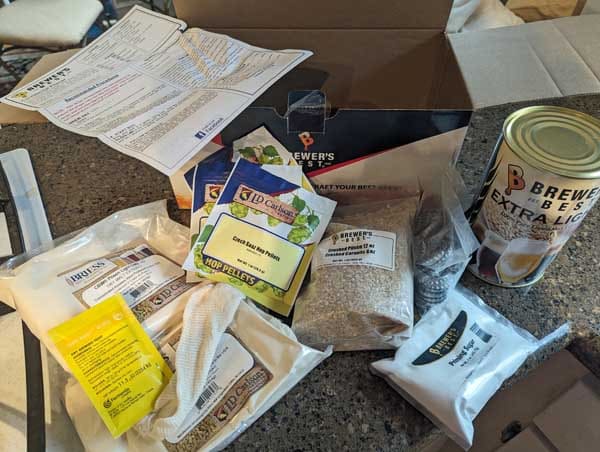
Last Updated on April 30, 2024 by Doug Hall
Continental Pilsner was our second extract beer recipe from Brewer’s Best. The first was an Imperial Pale Ale, which we review here.
We bought this kit on Amazon for $45.74 with free shipping as a Prime member. Brewer’s Best recipe kits include priming sugar, yeast, and bottle caps. Most other beer supply stores that sell recipe kits charge extra for yeast & bottling sugar. That total cost breaks down to about $0.95 per bottle or $5.70 per 6-pack. Not bad!
Introduction
Our first impression was bad when we noticed the expiration date on the can of liquid malt extract was 6 months away. Considering the expiration date on the can from our first recipe was 11 months out, we knew this recipe had been sitting on a shelf for a long time.
Pilsner Urequell is the best commercial example of this style of beer. We had made this style once before and our recipe included 6 ounces of Czech Saaz hops. This kit came with just 3 ounces. That was our second clue that this may not live up to the true style. We were, unfortunately, right.

Brewer’s Best Continental Pilsner Ingredients:
Fermentables:
- 3.3 lbs. Extra Light LME
- 2 lbs. Pilsen DME
Specialty Grains:
- 12 oz. Pilsen
- 4 oz. Carapils
Hops:
- 3 oz Czech Saaz
Yeast:
- S-23 Saflager Yeast

Cooking the Brewer’s Best Continental Pilsner Recipe
This recipe has a few extra steps but is still relatively simple.
As always, we started with 2.5 gallons of tap water in our brew kettle and steeped the grains once the strike water temperature got to 150 degrees.
We then turned the heat down to keep the temperature below 170 degrees and steeped the grains for 20 minutes. Once the steeping grains have been removed, I turn the heat back to high.
I remove the kettle once a boil is achieved, Add the 3.3 pounds of liquid malt extract and spend a few minutes to get it mixed in well. You don’t want any of that extract to scorch on the bottom of the pot.
Once that is complete, put it back on the burner and get it back to a boil. At this point add 2 ounces of the Czech hops. As always, watch for boilovers. This is where it is a huge advantage to have a gas cooktop, making it easy to lower the burner quickly.
After 30 minutes, add the last pack of 1 ounce of the Czech Saaz hops.
15 minutes later, after 45 minutes of boil time, remove the pot from the burner and add the 2 pounds of dried malt extract. DME will clump. I use a large stainless steel whisk that can reach the bottom of the pot to make sure all the DME is blended into the wort. This can take 5 to 15 minutes, depending on how much DME is being added.
Get the pot back on the burner. Wait until it reaches a boil again to start the timer for the final 15 minutes.
With 10 minutes remaining, I add a Whirfloc clarifying tablet. Terminate the boil and put that pot into an ice bath.
I usually add close to 1 gallon of cold, filtered water into the pot to help reduce the temperature faster. Another 1.5 gallons go into the fermenter. Once the temperature is cool enough, I pour the wort into the fermenter and aerate it.
Primary and Secondary Fermentation
The yeast that came in the Brewer’s Best Continental Pilsner recipe was Saflager S-23. The ideal temperature range is between 53 and 59 degrees. I set the external thermostat to my spare garage refrigerator to 56 degrees. Primary fermentation was complete after 7 days.

After 10 days, I brought the fermenter into the house for a diacetyl rest that lasted 3 days. I racked the beer into a secondary fermenter and put it back into my spare refrigerator which had been set to 34 degrees. I let it lager in the fridge for 28 days before proceeding to bottle.
I have a couple of 2-gallon corny kegs, so I decided to keg about half the yield and was able to get 28 bottles filled afterward.
The Tasting Notes

Comparing the color, the Brewer’s Best Continental Pilsner looks almost exactly like a Pilsner Urquell. Unfortunately, that is where the comparison ends.
The ABV was 4.4%, making this an easy-to-drink beer. It is just… boring. The hoppiness is nowhere near a Pilsner Urquell. You get a tease of the Saaz hops on the back of your tongue but not as bold as it should be.
There isn’t much to the nose to brag about. It does have a full, compact white head that laces down the glass nicely. It is certainly dry and smooth like a lager should be. There’s also the distinct malty taste derived from the Pilsner Malt and the Pilsen specialty grains. Those grains allow it to stand a little different from many other beers. It is just a very toned-down version of a true Czech Pilsner.
The Final Numbers
| Color | SRM Score | 5-Pale Gold  |
| Malty | 0 to 10 | 5 |
| Hoppy | 0 to 10 | 3 |
| Bitterness | IBU score (0-120) | 25 |
| Alcohol | ABV % | 4.4% |
Brewer’s Best Continental Pilsner Conclusion
I’m no hop head but this missed the mark for what it aspired to be. It is almost a little too bitter for those who only want malt-forward beers or those used to drinking the mass-produced crap. It is not even close to the complexity of flavor or true Saaz hops profile you expect and want from a Bohemian-style Pilsner.
Overall, Brewer’s Best Continental Pilsner is not a recipe I would try again. Between the dated ingredients and the lack of depth of flavor, this is one and done-for me.
- Mango Kolsch Beer Recipe Review - May 2, 2024
- Helles Lager Beer Recipe Review - May 2, 2024
- What is the Beer Bitterness Scale? IBU Simplified - April 24, 2024
